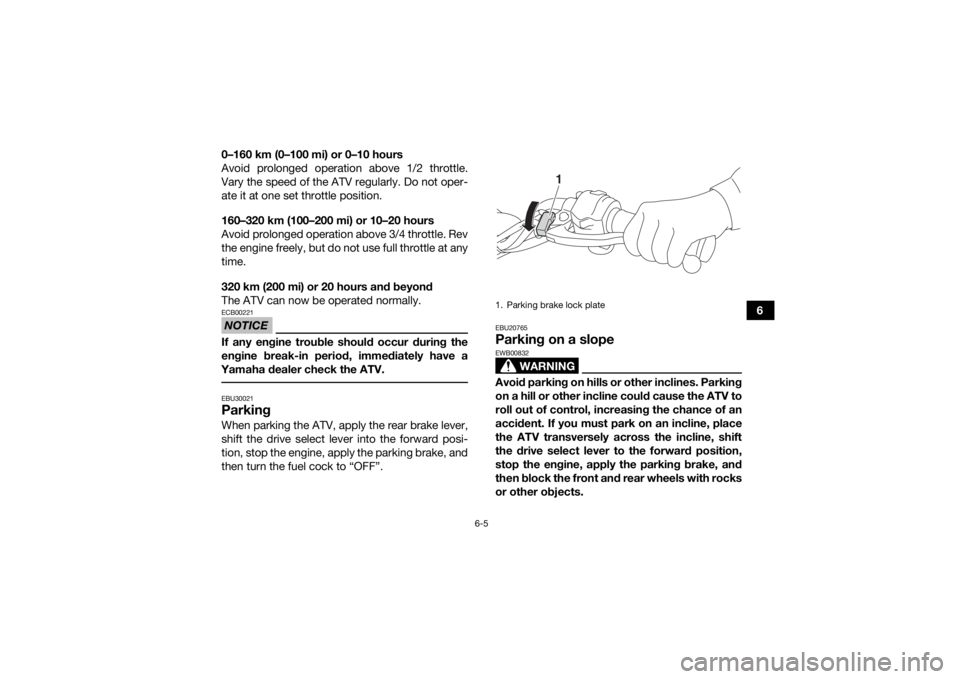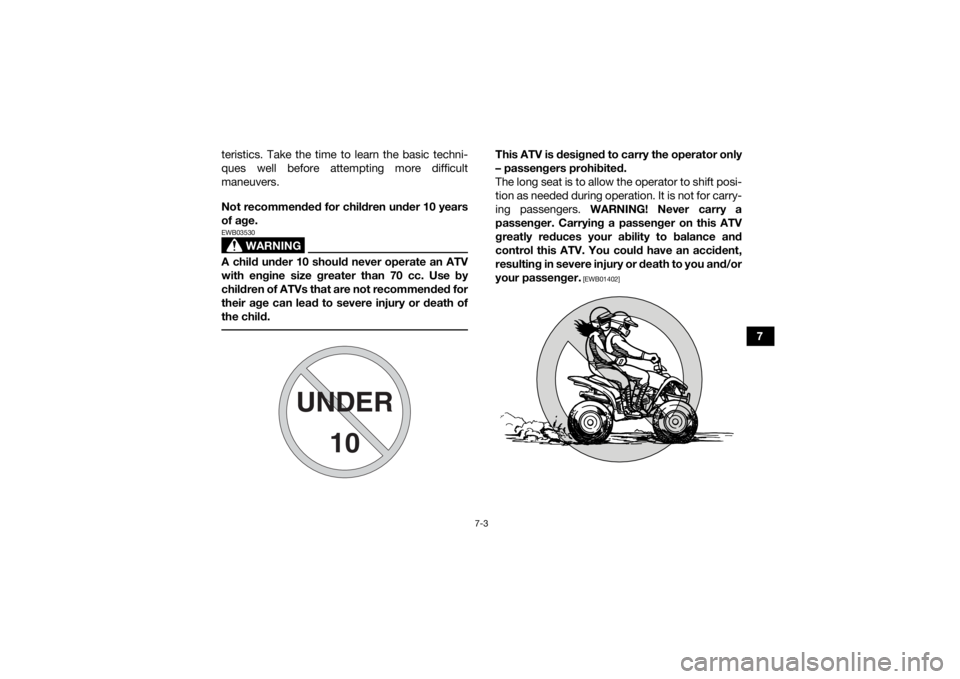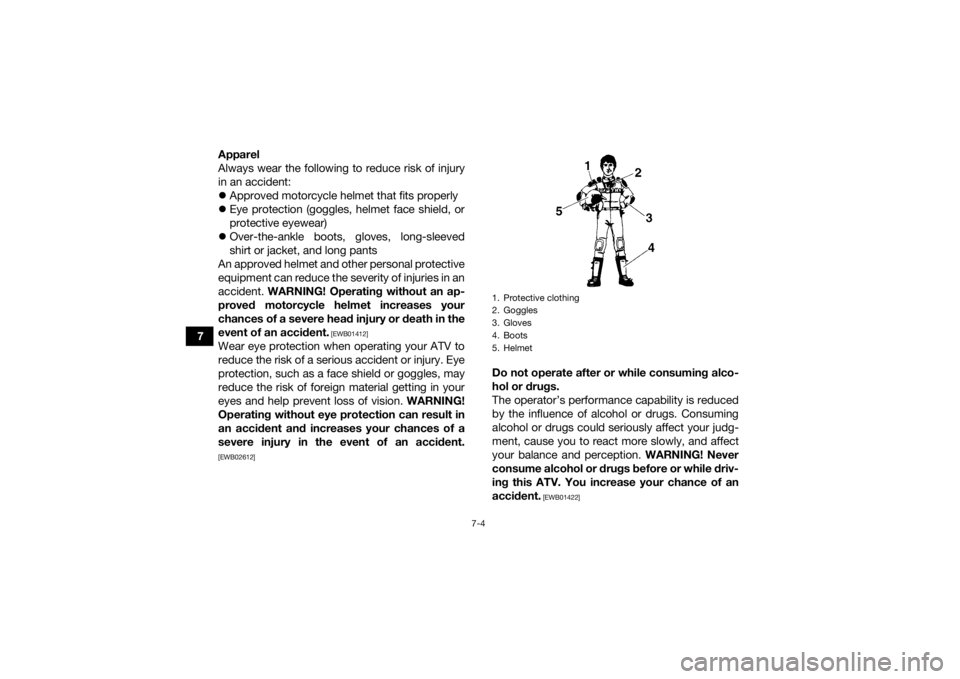2017 YAMAHA YFM90 warning
[x] Cancel search: warningPage 53 of 130

6-1
6
EBU19882
OPERATION
EBU19902Read the Owner’s Manual carefully before riding
the ATV. If there is a control or function you do not
understand, ask your Yamaha dealer.
WARNING
EWB00632Read the Owner’s Manual carefully to become
familiar with all controls in order to help pre-
vent any loss of control, which could cause an
accident or injury. EBU33821Starting a cold engineNOTICEECB00151See the “Engine break-in” section on page 6-4
prior to operating the engine for the first time. 1. Set the parking brake. (The engine can bestarted only when the rear brake lever is ap-
plied.)
2. Turn the fuel cock to “ON”. 3. Turn the key to “ON” and set the engine stop
switch to “ ”.
4. Shift the drive select lever into the neutral po- sition. (The neutral indicator light should
come on.)
5. Use the starter (choke) in reference to the fi- gure:
Position (1):
Cold engine start with ambient temperature
below 5 °C (40 °F).
Position (2):
Cold engine start with ambient temperature
between 0 °C (30 °F) and 30 °C (90 °F).
Position (3):
Cold engine start with ambient temperature
above 25 °C (80 °F).
UBD361E0.book Page 1 Monday, January 25, 2016 10:53 AM
Page 55 of 130

6-3
6
EBU20292Starting a warm engineFollow the same procedure as for starting a cold
engine, with the exception that the starter (choke)
is not required when the engine is warm. Instead,
start the engine with the throttle slightly open.EBU33831Operating the drive select lever and
driving in reverseNOTICEECB00171Before shifting, stop the ATV, otherwise the
transmission may be damaged. Shifting: Forward1. Bring the ATV to a complete stop.
2. Apply the rear brake lever.
3. Shift from neutral to forward by moving the drive select lever along the shift guide.TIPMake sure that the drive select lever is completely
shifted into position.
4. Open the throttle lever gradually.
Shifting: Reverse
WARNING
EWB00721Improper operation in reverse could make you
hit an obstacle or even a person behind you,
resulting in serious injury. When you shift into
reverse, make sure there are no people or ob-
stacles behind you. When it is safe to proceed,
go slowly. 1. Drive select lever
2. F (Forward)
3. N (Neutral)
4. R (Reverse)
FNR
234
1
UBD361E0.book Page 3 Monday, January 25, 2016 10:53 AM
Page 57 of 130

6-5
6
0–160 km (0–100 mi) or 0–10 hours
Avoid prolonged operation above 1/2 throttle.
Vary the speed of the ATV regularly. Do not oper-
ate it at one set throttle position.
160–320 km (100–200 mi) or 10–20 hours
Avoid prolonged operation above 3/4 throttle. Rev
the engine freely, but do not use full throttle at any
time.
320 km (200 mi) or 20 hours and beyond
The ATV can now be operated normally.
NOTICEECB00221If any engine trouble should occur during the
engine break-in period, immediately have a
Yamaha dealer check the ATV. EBU30021ParkingWhen parking the ATV, apply the rear brake lever,
shift the drive select lever into the forward posi-
tion, stop the engine, apply the parking brake, and
then turn the fuel cock to “OFF”.
EBU20765Parking on a slope
WARNING
EWB00832Avoid parking on hills or other inclines. Parking
on a hill or other incline could cause the ATV to
roll out of control, increasing the chance of an
accident. If you must park on an incline, place
the ATV transversely across the incline, shift
the drive select lever to the forward position,
stop the engine, apply the parking brake, and
then block the front and rear wheels with rocks
or other objects.1. Parking brake lock plate
1
UBD361E0.book Page 5 Monday, January 25, 2016 10:53 AM
Page 59 of 130

6-7
6
aftermarket products or having other modifica-
tions performed to your ATV that change any of
the vehicle’s design or operation characteristics
can put you and others at greater risk of serious
injury or death. You are responsible for injuries re-
lated to changes in the vehicle.
Keep the following in mind when considering an
accessory or operating an ATV which has acces-
sories.
Accessories should be rigidly and securely
mounted. An accessory which can shift position
or come off while you are riding could affect
your ability to control the ATV.
Do not mount an accessory where it could inter-
fere with your ability to control the ATV. Exam-
ples include (but are not limited to) a heavy or
bulky object attached to the handlebars which
could make steering difficult, an accessory that
limits your ability to move around on the seat, or
one that limits your view.
Use extra caution when riding an ATV with ac-
cessories. The ATV may handle differently than
it does without accessories.
EBU33880Loading
WARNING
EWB00821Never exceed the stated load capacity for this
ATV. Overloading this ATV or carrying or tow-
ing cargo improperly could cause changes in
ATV handling which could lead to an accident.
Cargo should be properly distributed and se-
curely attached. Reduce speed when carrying
cargo or pulling a trailer. Allow greater dis-
tance for braking. As originally equipped, this ATV is not designed to
carry cargo or tow a trailer. If you choose to add
accessories so that you can carry cargo or tow a
trailer, you must use common sense and good
judgment as the stability and handling of an ATV
can be changed. When adding accessories, keep
the following points in mind:
Never exceed the weight limits shown. An over-
loaded ATV can be unstable.
MAXIMUM LOADING LIMIT ATV loading limit (total weight of rider, car-
go, accessories, and tongue weight):82.0 kg (181 lb)
UBD361E0.book Page 7 Monday, January 25, 2016 10:53 AM
Page 62 of 130

7-2
7
EBU34101GETTING TO KNOW YOUR ATV
This ATV is intended for recreational use by young
operators under adult supervision. This section,
“Riding your ATV”, provides general riding instruc-
tions which are appropriate for all types of riding.
Riding your ATV requires special skills acquired
through practice over a period of time. Take the
time to learn the basic techniques well before at-
tempting more difficult maneuvers.
Riding your new ATV can be a very enjoyable ac-
tivity, providing you with hours of pleasure. But it
is essential to familiarize yourself with the opera-
tion of the ATV to achieve the skill necessary to
enjoy riding safely. Before you begin to ride, be
sure you have read this manual completely and
understand how to operate all of the ATV’s con-
trols. Pay particular attention to the safety infor-
mation on pages 2-1 to 2-6 and all notice and
warning labels on the vehicle.RIDE WITH CARE AND GOOD JUDGMENT
Beginning riders should get training from a
certified instructor.
WARNING
EWB01382
Do not operate this ATV or allow anyone else
to operate it without proper instruction. The
risk of an accident is greatly increased if the
operator does not know how to operate the
ATV properly in different situations and on
different types of terrain.
Do not operate this ATV at speeds too fast
for your skills or the conditions, as this in-
creases your chances of losing control of the
ATV and an accident. Always go at a speed
that is proper for the terrain, visibility and op-
erating conditions, and your experience. Riding your ATV requires skills acquired
through practice over a period of time.
Become familiar with riding this ATV by riding at
slow speeds first, even if you have experience rid-
ing other ATVs. Do not attempt to operate it at
higher performance levels until you are familiar
with this ATV’s handling and performance charac-
UBD361E0.book Page 2 Monday, January 25, 2016 10:53 AM
Page 63 of 130

7-3
7
teristics. Take the time to learn the basic techni-
ques well before attempting more difficult
maneuvers.
Not recommended for children under 10 years
of age.
WARNING
EWB03530A child under 10 should never operate an ATV
with engine size greater than 70 cc. Use by
children of ATVs that are not recommended for
their age can lead to severe injury or death of
the child.
This ATV is designed to carry the operator only
– passengers prohibited.
The long seat is to allow the operator to shift posi-
tion as needed during operation. It is not for carry-
ing passengers.
WARNING! Never carry a
passenger. Carrying a passenger on this ATV
greatly reduces your ability to balance and
control this ATV. You could have an accident,
resulting in severe injury or death to you and/or
your passenger.
[EWB01402]
UNDER
10
UBD361E0.book Page 3 Monday, January 25, 2016 10:53 AM
Page 64 of 130

7-4
7Apparel
Always wear the following to reduce risk of injury
in an accident:
Approved motorcycle helmet that fits properly
Eye protection (goggles, helmet face shield, or
protective eyewear)
Over-the-ankle boots, gloves, long-sleeved
shirt or jacket, and long pants
An approved helmet and other personal protective
equipment can reduce the severity of injuries in an
accident. WARNING! Operating without an ap-
proved motorcycle helmet increases your
chances of a severe head injury or death in the
event of an accident.
[EWB01412]
Wear eye protection when operating your ATV to
reduce the risk of a serious accident or injury. Eye
protection, such as a face shield or goggles, may
reduce the risk of foreign material getting in your
eyes and help prevent loss of vision. WARNING!
Operating without eye protection can result in
an accident and increases your chances of a
severe injury in the event of an accident.[EWB02612]
Do not operate after or while consuming alco-
hol or drugs.
The operator’s performance capability is reduced
by the influence of alcohol or drugs. Consuming
alcohol or drugs could seriously affect your judg-
ment, cause you to react more slowly, and affect
your balance and perception. WARNING! Never
consume alcohol or drugs before or while driv-
ing this ATV. You increase your chance of an
accident.
[EWB01422]
1. Protective clothing
2. Goggles
3. Gloves
4. Boots
5. Helmet
UBD361E0.book Page 4 Monday, January 25, 2016 10:53 AM
Page 65 of 130

7-5
7
Pre-operation checks
Always inspect your ATV before use to make sure
that it is safe operating condition. Perform the pre-
operation checks listed on page 5-1. Follow the
maintenance schedules and procedures as de-
scribed in the “Periodic Maintenance and Adjust-
ment” section of this manual.
WARNING! Failure
to inspect the ATV before riding it or failure to
maintain it properly increases the possibility of
an accident and equipment damage.
[EWB01433]
Speed limiter
For beginning riders, riders less experienced with
this model, or whenever limited speed is desir-
able, the throttle lever housing is equipped with a vehicle speed limiter. The speed limiter keeps the
throttle from fully opening, even when the throttle
lever is pushed to the maximum. Turning in the
adjusting screw limits th
e maximum engine power
available and decreases the maximum speed of
the ATV. Turning in the adjusting screw decreases
top speed, and turning it out increases top speed.
(See page 4-3.)
This model also has an engine speed limiter plate
to limit the amount of engine power available.
Yamaha recommends that all beginning riders start off with the engine speed limiter plate in-
stalled and the vehicle speed limiter adjusting
screw turned in to limit the amount of speed avail-
able while they learn. The vehicle speed limiter
may be gradually adjusted to increase maximum
speed as the beginner becomes more familiar with
operating the ATV. Parents should decide when to
adjust the ATV for more power as their young-
ster’s riding skills improve. Once the ATV rider can
operate with skill at the top speed permitted by
adjusting the vehicle speed limiter alone, the en-
gine speed limiter plate can be removed. Since re-
moval of this plate will result in a significant
increase in power, turn the vehicle speed limiter